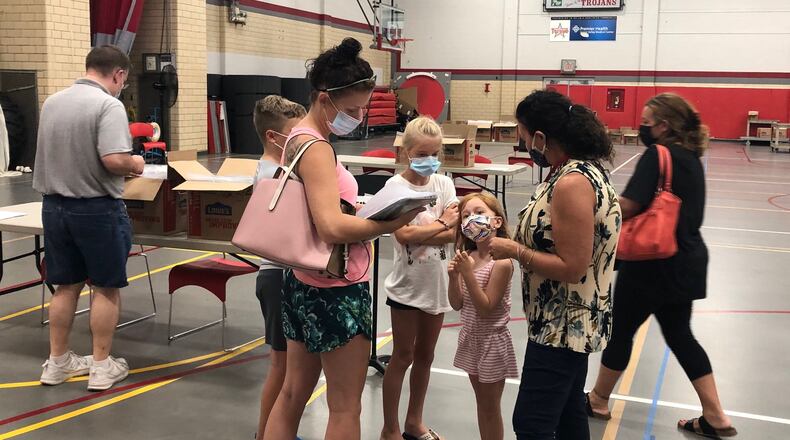But like nearly everything in education, the situation is different from student to student. So the first step for schools is to diagnose where each child stands. The purpose of those tests is not to give students a grade, but to make plans for the coming weeks and months.
The Dayton Leadership Academies charter school started Aug. 17 and is doing classes online for at least the first quarter. But Principal Tess Mitchner Asinjo said as part of Weeks 2 and 3, the school brought each student in for a few hours of in-person, one-on-one assessments with teachers.
“Teachers will analyze the results and create data-driven lessons for small groups,” Asinjo said, adding that students have customized assignments beyond full-class meetings. “Understanding students’ incoming skills and reading levels allows DLA to teach the state standards along with differentiated instruction.”
A bigger challenge
Troy and Lebanon school officials said they anticipate a wider academic disparity than the normal summer slide due to the abrupt mid-March school closures. Those closures led to an online learning model that kids weren’t used to, many educators weren’t prepared for, and some schools and families didn’t have the technology to support.
And some of the outside agencies that normally support education weren’t available either. Libraries, community centers and after-school programs were closed for long stretches.
Danielle Romine, the K-6 curriculum director for Troy City Schools, said her district invested more money into the online Kids Read Now program this summer to make sure students had access to all of the books.
Credit: Jeremy P. Kelley
Credit: Jeremy P. Kelley
When Troy starts school Tuesday (most kids in-person, some online), they’ll administer math and reading diagnostics the first week, then use that data to give individual students the help they need.
Troy created detailed documents to help teachers instruct more precisely on each English and math learning standard. The documents are organized by grade level, so for students who are behind in a certain area, teachers can build lessons that connect the previous grade’s skills with the class’s current activities to close those gaps.
Troy curriculum staff acknowledged that those interventions are more difficult when teacher-student interaction is inconsistent. But they said teachers, staff and administrators keep working to adapt.
“We’re optimistic that all the kids are going to get where they need to go,” Romine said.
Students who were picking up computers last Wednesday for Troy’s online classes were less worried and more excited about seeing friends and teachers, even if it’s online.
Sixth grader Skyler Shepherd and fifth grader Brayden Clark said it was amazing to have a long summer break, adding that they weren’t worried much about the impact on learning.
“It’s going to feel a bit different, but eventually we’re going to get used to it,” Shepherd said.
“I don't think it makes sense to overwork students to make up for lost time or lost gains. Everyone experienced losses. We want students to love learning, and we aren't going to achieve that goal by drilling them on what they missed due to the pandemic."
Lebanon started classes three weeks ago, and director of curriculum and instruction Mark Graler said in-person students took diagnostic tests last week and will again this week. Online students will take them later this month.
Graler said the big picture will be the same as always — find out where kids stand and advance them as far as possible with the intervention strategies that work best. But he said racing to ensure all kids catch up to a predetermined academic point as if nothing happened is “a pretty tall order.”
“I don’t think it makes sense to overwork students to make up for lost time or lost gains,” Graler said. “Everyone experienced losses. We want students to love learning, and we aren’t going to achieve that goal by drilling them on what they missed due to the pandemic.”
Choosing priorities
Ohio is a local-control state, so individual district largely choose their own strategies to recover from any spring learning loss.
While many schools are doing diagnostic testing immediately, Centerville schools spokeswoman Sarah Swan said teachers are focused on “building relationships and reestablishing the routines necessary for learning.” Teachers are doing some informal assessments, she said, but “the next layer for our curriculum department will be looking into how we will assess students using more formal tools.”
Bellbrook schools are doing testing now for in-person students, but Superintendent Doug Cozad said its too early to know how many students will meet traditional goals for academic growth.
Another focus for Bellbrook is designing appropriate online lessons for students who are learning remotely, using “more engaging, technology-rich curriculum tools.” Cozad said that could affect attendance and student success.
Many researchers say summer slide is a bigger issue for low-income families that have fewer resources to keep kids engaged in activities and learning during breaks.
Landon Brown, principal of Emerson Academy charter school in Dayton, said last month that learning loss is his No. 1 concern, because many students weren’t heavily engaged in the spring. He said he knows math proficiency is likely to suffer after the long break, and that’s a top focus this fall.
Dayton Public Schools Superintendent Elizabeth Lolli said student scores had been improving last school year, but once classes moved online, “a very large number of students” were not as engaged, and about 5% didn’t log on at all from March to May.
For online classes that start Tuesday, DPS reduced or eliminated many arts and elective classes to focus more on core academics. Lolli said diagnostic test results will be available around the third week of September “and we’ll be able to analyze that and see what we need to do.”
“We need to … make sure that we are picking our students up, teaching them academically what they need to know for the upcoming (state) tests, because the tests are not changing,” Lolli said. “I think we need to still consider that academically, we are behind from the last nine weeks of (last school year).”
Steps to help students
Dayton Early College Academy Superintendent Dave Taylor said DECA is wrapping up diagnostic testing this week and he expects to see some evidence of “the COVID slide.”
“Learning loss is always an issue … This year is even more pressing,” Taylor said.
DECA is online for the first quarter. Teachers are working with small groups of kids and planning extra interventions to at-risk students, but Taylor said that’s harder in a remote model.
“Offering interventions remotely for students who are struggling with remote learning doesn’t make a whole lot of sense, so we have to get creative,” he said.
DECA was proactive this summer in asking families what support they needed,Taylor said, and establishing expectations for the school year. It’s a school priority to do outreach before students can fall far behind.
Schools are taking all kinds of steps like that — a new program in Lebanon to identify math content students missed and fill in the gaps; surveys on student stress areas in Troy so they can develop support groups based on student needs; Dayton planning in-person troubleshooting visits to students who aren’t showing up online.
“Our teachers are putting a tremendous amount of effort into their lessons, their videos and their assignments,” Taylor said. “We know the stakes are high for students and I’m confident that we’ll move through this year in partnership with our families, doing what’s best for our kids.”
FINAL LOCAL SCHOOLS/DISTRICTS TO START THE 20-21 YEAR
Schools offering a choice of 100% in-person or 100% online
Fairborn: Sept. 8 start
Piqua: Sept. 8 start
Bradford: Sept. 8 start
Milton-Union: Sept. 8 start
Miamisburg: Sept. 8 start
Franklin: Sept. 8 start
Carlisle: Sept. 8 start
Wayne Local: Sept. 8 start
Springboro: Sept. 8-11 start
Schools going fully online for at least the first quarter
Kettering: Sept. 8 start
Dayton: Sept. 8 start
Northridge: Sept. 8 start
Jefferson Twp.: Sept. 8 start
Imagine Klepinger: Sept. 8 start
Others
Troy: Sept. 8 start, choice between 100% online and adjustable model. Adjustable in-person model is currently set for full five days per week.
Valley View: Sept. 8-9 start, had choice of fully online school or a hybrid with 1-2 days per week in-person and the rest online.
Mad River: Sept. 8-9 start, had choice of fully online school or a hybrid with 2-3 days per week in-person and the rest online.
About the Author


